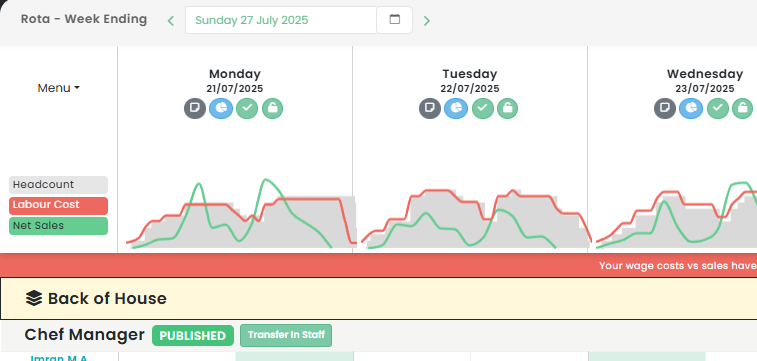Stay informed with industry news, tips, and practical guides for hospitality professionals.
The restaurant industry is renowned for its dynamic and fast-paced environment, but achieving financial success can be challenging. One of the key indicators of a restaurant’s financial health is its net profit margin—the amount of profit a restaurant makes after all expenses are deducted from revenue. Understanding what constitutes a healthy net profit margin and how to improve it is crucial for long-term success in the hospitality business.
In this blog, we’ll provide a detailed breakdown of net profit averages in the restaurant industry and offer some practical cost-saving tips to help you boost profitability.
Net profit is the amount of money your restaurant retains after deducting all operating expenses, including food costs, wages, utilities, rent, marketing, and taxes, from total revenue. It is often expressed as a percentage of revenue, and this percentage is referred to as the net profit margin.
Net profit margins can vary significantly depending on the type of restaurant, location, and business model. However, industry benchmarks provide a general idea of what is typical in the restaurant business:
While these numbers are averages, it’s essential to note that various factors can affect profit margins, such as location, seasonality, management, and economic conditions.
Several major expenses directly affect a restaurant’s net profit. Understanding these costs and how to control them can lead to significant improvements in profitability.
Food costs, or cost of goods sold (COGS), represent one of the largest expenses for restaurants. On average, food costs should make up 28% to 35% of your total revenue. However, this can vary based on the type of menu, food pricing, and portion sizes.
To improve food cost efficiency, consider:
Labour costs typically account for 25% to 35% of a restaurant’s total revenue, depending on the restaurant’s size and service model. Labour costs include wages, benefits, taxes, and payroll processing fees.
To reduce labour costs, consider:
Rent and utility costs are fixed expenses that can take a big chunk out of your profits. The cost of rent will vary significantly based on your restaurant's location, with prime city centre locations generally commanding higher rents. Utility costs such as electricity, water, and gas can also add up.
To minimise these costs, consider:
While controlling major expenses is crucial, there are also other ways to boost your restaurant’s net profit margin. Here are some cost-saving tips:
Technology can streamline operations, improve efficiency, and save money. Point-of-sale (POS) systems, inventory management tools, and reservation systems can help improve accuracy, reduce human error, and optimise workflows.
Examples of Technology Solutions:
Investing in the right marketing strategies can increase foot traffic and generate more sales, which in turn improves net profit. Digital marketing (such as social media campaigns and email newsletters) is highly cost-effective and can yield significant results.
Effective Marketing Strategies:
Consistently reviewing your financial statements and key performance indicators (KPIs) allows you to identify areas where costs can be reduced or revenue can be increased. Regular audits can highlight inefficiencies, unprofitable menu items, and areas where expenses can be trimmed.
Financial Review Tips:
Net profit margins in the restaurant industry can vary, but understanding the averages and key expenses is essential for long-term success. By focusing on controlling food costs, labour expenses, rent, and utilities, and implementing smart cost-saving strategies, you can improve your restaurant's financial health.
Additionally, leveraging technology, investing in marketing, and reviewing financial performance regularly can help you make more informed decisions that boost profitability. With the right strategies in place, your restaurant can thrive and achieve a sustainable net profit margin.
Speak with an Opsyte expert to see how we help:

“Opsyte transformed our entire back office. Game changer.”
Revolutionising the UK Hospitality Scene: Pub Promotions Ideas for Explosive GrowthIn the throbbing heart of the UK's dynamic hospitality industry, pubs and bars hold a special place. From traditional establishments…...
Promotions for Bars: The Ultimate Guide to Boosting Your Hospitality BusinessIn the competitive world of hospitality, particularly in the UK, bars must stay ahead of the curve to attract and…...
Restaurant analytics is the habit of turning everyday numbers into smarter, faster decisions. In the UK, operators who use data well often see 3 to 6 percentage points improvement in…...
Restaurant Analytics: Transforming the UK Hospitality Industry Through Data-Driven DecisionsThe hospitality industry, particularly the food business, has seen significant evolution in recent years. One of the key factors driving this…...
Average Profit Margin for Restaurants in the UK: A Comprehensive AnalysisUnderstanding the financial dynamics of the hospitality industry, particularly the metrics surrounding restaurant profit margins, is crucial for restaurant owners…...
Exploring QSR Franchise Opportunities in the UK Hospitality SectorThe United Kingdom's hospitality sector boasts a diverse landscape of businesses, with one of the most significant being the Quick Service Restaurant…...